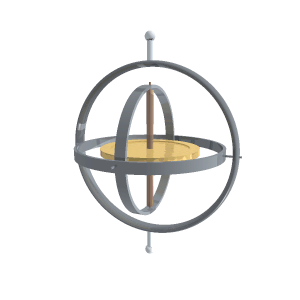I needed a definition for this.
Pre⋅ces⋅sion [pree-sesh-uhn]
noun
1. the act or fact of preceding; precedence.
2. Mechanics. the motion of the rotation axis of a rigid body, as a spinning top, when a disturbing torque is applied while the body is rotating such that the rotation axis describes a cone, with the vertical through the vertex of the body as axis of the cone, and the motion of the rotating body is perpendicular to the direction of the torque.
I don't think that does a very good job of explaining it.
Basically the way it works is that a spinning mass will act like a gyroscope. There are two primary characteristics of a gyro:
1) Rigidity in space: the gyro has a tendency to resist forces applied to it, it is stable on the axis it spins. This is the principle behind which a spinning top stays upright, and the incorporation of gyroscopes in flight instrument have resulted in instruments like the artificial horizon which by maintaining rigidity in space allow for flight solely by reference to the instruments.
 2) Precession:
2) Precession: when a force is applied perpendicular to a spinning rotor the rotor will resist the force where it is applied and the force will manifest 90 degrees later in the direction the rotor is spinning.


If you have have spun a bicycle tire that was not mounted to the bike you have no doubt noticed the somewhat peculiar nature of a gyroscope:
MIT Physics Demo -- Bicycle Wheel Gyroscope (The video's owner prevents external embedding)
To put that into flight dynamics terms the propeller/propeller + rotary engine will act like the gyro, and any pitch or yaw changes of the aircraft can be thought of forces applied to the disk of the rotor. For example, pitching up as in a loop can be thought of like pulling the propeller disk at the 12 oclock position (applied force), assuming the propeller rotates clockwise (as viewed by the pilot) the force will manifest 90 degrees later, at the 3 oclock position as if the pull on the prop disk happened there. In other words the airplane will yaw to the right you pull the nose up for the loop, it will yaw the nose to the left when you push forward on the stick, it will cause the nose to rise when you apply left rudder pressure, and the nose will be driven down when the pilot applies right rudder.The more abruptly the pitch or yaw deviation, the more obvious this gyroscopic precession will be. Also, the greater the RPM/diameter/mass of the gyro, the greater the resultant gyroscopic action.
In a plane like the DrI, Sopwith Camel and the N17/N28 to a lesser extent a pilot trying to make a level turn will roll the airplane and then apply aft elevator inputs, as we've already discussed this means the nose of the airplane will be driven to the right and the pilot will need to compensate with a left rudder application. This happens in both left or right turns since the elevator input is what is driving the gyroscopic effects and that is common to conventional turns in either direction. This is different than a pilot of a modern aircraft who would generally need to apply rudder in the direction of the turn to prevent a slipping turn (uncoordinated flight). This same dynamic will manifest when applying abrupt rudder commands, pitch inputs will need to be made in order to compensate for gyro effects.
Here's some greater details:
http://www.history.com/encyclopedia.do?vendorId=FWNE.fw..gy117200.a#FWNE.fw..gy117200.a
